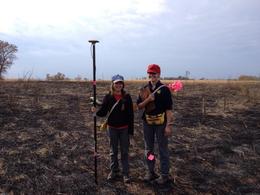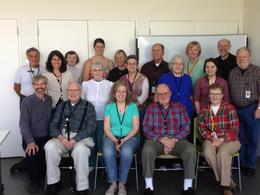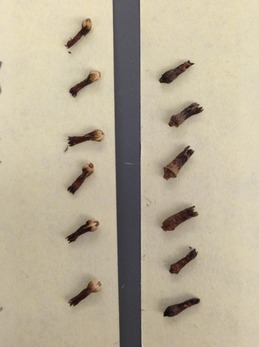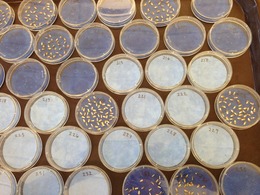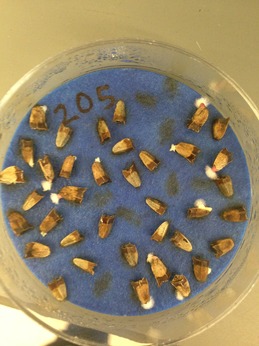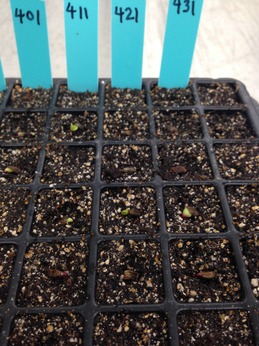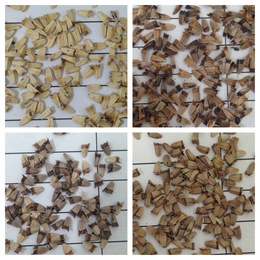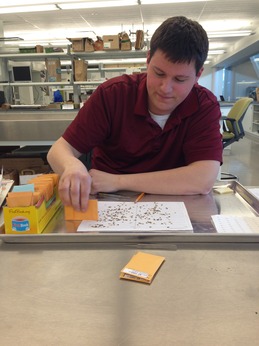Today is my last day working for Stuart at the Chicago Botanic Garden and I can’t stress enough how wonderful an experience this year has been! I’m not quite sure where my next adventures will take me, but I’m very grateful to have worked here and I know I’ll take all the skills I’ve learned onto whatever comes my way in the future. Good luck to team Echinacea 2014!
|
||||
|
Alex Yeaney, our intern from Lake Forest College this spring, finished up his report on the effects of a specialist aphid on Echinacea. Check out his report to find out his results! We had a very quick and efficient planting last week. Stuart and I drove up to MN on Thursday morning, picking up Katherine Muller on the way in St. Paul. We arrived in Kensington on Thursday evening, and immediately got to work. We broadcasted our remaining little bluestem and side oats gramma grass seeds in the South Field (where we planted our qGen2 achenes this fall, aka CG-8). We walked E/W throughout the plot and each broadcast seed over a 5m area. We also broadcast seed around the edge of the plot. Here’s an inventory of how much we broadcast from each of the collection sites: Peninsula – 1 quart We then headed to Hegg Lake to scout out a planting site for the sprouts. We settled on a spot near the parking area, to the west of Amy’s, Caroline’s, and the recruitment plots. The plot is 12m x 30 m with 13 rows and 60 positions. There is a meter spacing between rows and half a meter between positions. We returned the next morning and began planting by 9:30am. With three of us we were very efficient and finished our last row by 3:30pm. We we lucky to have beautiful weather, it was sunny all day with temperatures in the low-mid 70s and a consistently strong breeze. All positions in the plot were plant-able. Here’s a diagram of the plot: Empty circles indicate positions where a sprout was planted and black dots indicate positions where there are nails. Plants begin at position 0.5 in every row. Row 41 is the most western row, and position 0 is closest to the road (and north). There are empty positions at the ends of rows 46 and 48. There is a bent over flag at each of the 4 corners of the plot. I’m excited to have the sprouts in the ground and to have participated in my first planting. Fingers crossed we have high survival! Spring has caught up with us quickly and now it’s almost summer. We’re getting prepared for a new field season and finishing up some of our lab projects. Our sprouts are in the ground! It’s been quite the germination process. We had an overall germination rate of 97% for all sprouts with a E. pallida mother and an overall germination rate of 87% for sprouts with an E. angustifolia mother. That’s a lot higher than we expected! Consequently, our plug trays were very full. Germination also spanned more than a month, with our first radicals emerging on April 7th and our last emerging on May 8th. We measured all sprouts when they were 21 days old and decided to take leaf tissue samples when they were 28 days old. The tallest sprout was a whopping 7.4 cm. We took leaf samples primarily to be able to analyze the sprouts’ DNA and perform paternity tests since we also have tissue from their parents. This will be a project for a future date. Alex, our Lake Forest College intern, has finished up his analysis on the heads in the aphid addition/exclusion experiment and is working on a report that we will post in the coming weeks. We had our annual Volunteer Appreciation Potluck last week. Gia came and presented some of her ant data and Gretel and I talked about some of our recent research. We’re so lucky for all the help we receive from our volunteers, we really couldn’t do our research without them. Although there are many steps in Echinacea workflow process (cleaning, scanning, counting, randomizing, and weighing/x-raying) we decided to recognize one of our volunteers, Lois, as the “Achene Queen.” Since we’ve transferred all our counting to an online database, Lois has counted over 350,000 achenes! While it may seem obvious, here at the Echinacea Project we look at a lot of Echinacea. With such large numbers–thousands of plants each summer and heads each winter– we’re used to a certain degree of variation. Bracts differ in length and degree of “pokey-ness”, trichome density varies among leaves, and achenes range in size and color (see the post “A Palette of Pallida” from March 21st for an example). This morning one of our volunteers, Suzie, noticed that the florets on the head she was cleaning had a distinctly different shape and color. The florets come from CG-6152 wht, or plant 27, 915 in the quantitative genetics (qGen) section of the common garden. Below is is a side by side view of these unusual florets (on the left) compared with what we typically see. This is the first time we’ve seen this sort of variation in floret shape and color in the lab. Right now we can’t say for certain what caused it, whether it’s natural variation or a response to insect herbivory, for example. It’ll be interesting to visit this plant next year, however, and see if this variation persists and is conspicuous when the plant is flowering. It’s finally beginning to feel like spring here at the Chicago Botanic Garden and with the change in seasons, we’ve got some new projects in the lab. All those E. pallida and E. angustifolia seeds I was weighing a couple weeks ago have been germinated and I’m in the process of transferring the sprouts to plug trays. The achenes first went through a two week cold-stratification, pre-germination treatment. I kept the achenes in petri dishes, evenly spread on blotter paper and put them in the refrigerator (4 degrees C), making sure to keep them well moistened throughout this time period. After two weeks I transferred the achenes to the growth chamber where it was significantly warmer (25 degrees C) and put them close to the light. Sprouts are ready once their radicle emerges 1 mm. Nearly 20% of the seeds germinated within 24 hours of being transferred to the growth chamber, and even more germinated the following day. We place sprouts in plug trays were they’ll grow up for the next 5-7 weeks before being transplanted in the ground. And man oh man do they grow up fast! Can you spot the sprouts in this section of the plug tay? We like to tell anyone that volunteers or works in the lab that Echinacea achenes come in all shapes and sizes. Here’s an example: Now if you can’t already tell, these are not the achenes you may be used to seeing. These are all achenes from Echinacea pallida, a purple cone flower species not native to Minnesota but planted in some restorations within our field site. These specific achenes come from Hegg Lake, and they are some of the same achenes that Grace and Aaron, our interns from December, weighed and x-rayed in their analysis modeling hybridization between E. angustifolia and E. pallida. We are going to germinate and grow up some of these plants to see if hybridization is occurring in nature. Nicolas and Shona demonstrated hybridization between ANG and PAL was possible and viable through their artificial crosses, Dayvis concluded that the two species have overlapping flowering phenologies and pollinator assemblages, and Grace and Aaron modeled seed set of PAL and ANG heads collected this year and concluded that the model that best explains their data is one where the two species interbreed. So do they?!?!? We’ll let you know. It’s not actually madness in the lab right now. But we do have a few new things going on. Alex, a senior from Lake Forest College, starting working with us last week. He’ll be analyzing the achenes from heads in our aphids experiment. If you recall, this is an experiment that Katherine began in 2011 that involved adding or excluding aphids from 100 plants in the common garden. We’re interested if aphids have any effect on plant fitness and Alex will be looking at achene count and achene weight to see if there’s a difference between plants in our addition or exclusion treatments. He just started randomly sampling 30 achenes for the weigh machine today! In other news, we’ve got our volunteers hard at work cleaning and counting. We’re still working on counts from 2011, BUT we’re making progress. It’s been a while flog followers! I hope I haven’t lost any of you with my somewhat infrequent posting. But I’m back and here to tell you that things are moving along at the Chicago Botanic Garden! We’re progressing with the 2013 CG heads, tweaking and improving our protocols as we go in hopes of making things even more efficient. We’ve got a new volunteer in the lab and tomorrow will be the first day of our new intern. There will be more details in more posts to follow (I promise). In other news: Kory Kolis and Sarah Baker (2013 Team members) gave some nice presentations at their schools this fall about their research with Echinacea. If you recall, Kory examined pollinator efficiency and Sarah looked at flowering phenology in remnants. Check out their work below! Check out the awesome final report that Aaron and Grace wrote about their work during their December internship. It details how they modeled hybridization between E. angustifolia and E. pallida from Hegg Lake. Cool stuff! |
||||
|
© 2025 The Echinacea Project - All Rights Reserved - Log in Powered by WordPress & Atahualpa |
||||

